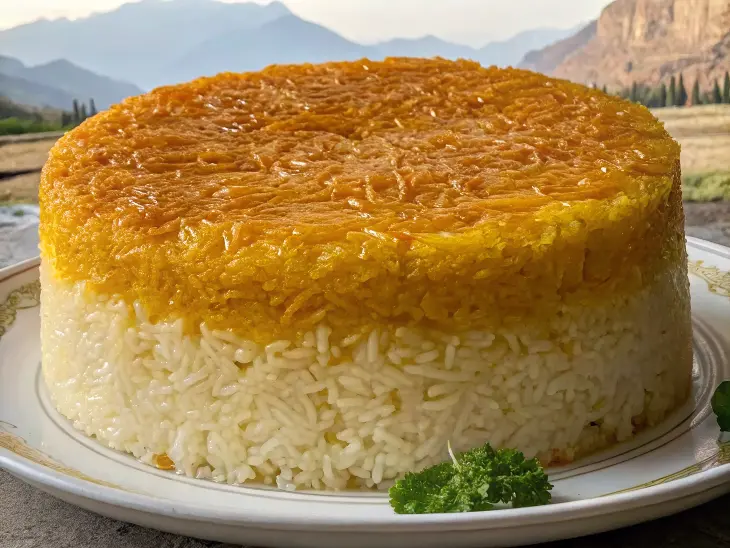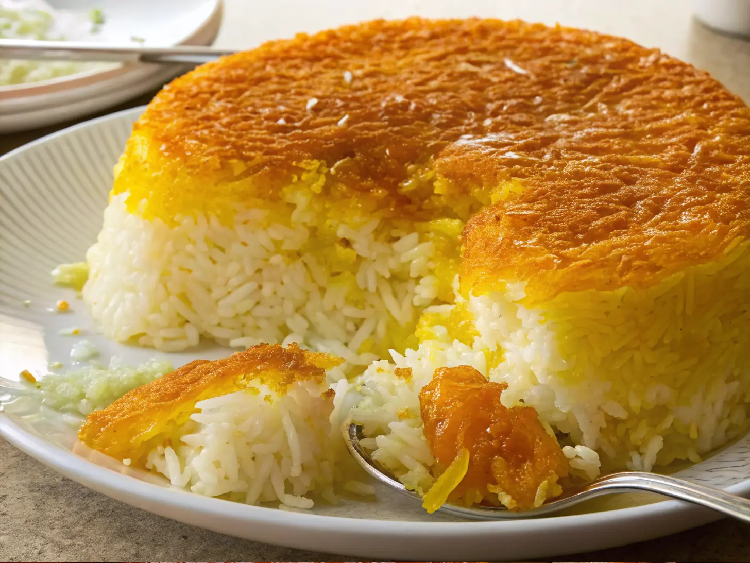The first time I successfully flipped a perfect golden disk of tahdig onto a serving platter, the excitement in the room was palpable. My Persian friend’s mother clapped her hands together and nodded in approval—I had finally mastered what many consider the crown jewel of Persian cuisine after months of practice and countless failed attempts.
Persian rice with its crispy tahdig bottom isn’t just a side dish—it’s the cornerstone of Persian culinary tradition, a dish that transforms humble grains of rice into something transcendent. The contrast between the delicate, fluffy grains above and the golden, crunchy layer below creates a textural experience unlike anything else in the culinary world.
In this comprehensive guide, I’ll share everything I’ve learned through years of testing and refinement, including the scientific principles that ensure success, the cultural significance of each step, and most importantly, a foolproof method that will help you create restaurant-quality Persian rice in your American kitchen, even if you’ve never attempted it before.
What is Tahdig?
Tahdig (pronounced tah-DEEG) literally translates to “bottom of the pot” in Persian. It refers to the crispy, golden layer that forms at the bottom of the pot when making Persian-style rice. While often considered the prized portion of the dish that family members might good-naturedly fight over, tahdig isn’t simply an accident or byproduct—it’s an intentional culinary achievement that requires specific techniques to perfect.
In Persian households, offering tahdig to guests is considered a sign of respect and hospitality. The quality of one’s tahdig often serves as a measure of culinary prowess, with the perfect specimen being uniformly golden (not burnt), crispy yet slightly chewy, and able to hold together as a complete disk when inverted onto a serving platter.
While rice tahdig is the most common variety (and the focus of this guide), tahdig can also be made with:
- Lavash bread: Thin flatbread lines the bottom of the pot
- Potato: Thinly sliced potatoes create the crispy base
- Lettuce: Less common but creates a unique flavor profile
- Yogurt: Mixed with rice for a creamier, tangier crust
Each family typically has its preferred style, often passed down through generations with subtle variations that make their version unique.
The Science Behind Perfect Persian Rice
Creating exceptional Persian rice involves understanding several scientific principles:
1. Starch Behavior
Persian rice cooking employs a two-stage process that manipulates rice starch in specific ways:
- Initial par-boiling: This stage partially gelatinizes the starch, where water molecules enter the starch granules causing them to swell. The crucial timing of this stage prevents complete gelatinization while removing excess surface starch.
- Steam-cooking (dam keshidan): The gentle steaming allows the rice to finish cooking through gradual moisture absorption while keeping the grains distinct rather than sticky.
Through testing dozens of batches, I’ve found that removing the rice from the par-boiling stage when it’s “al dente” (with a small white core still visible when a grain is broken) provides the optimal texture after steaming.
2. Maillard Reaction for Tahdig
The golden color and complex flavor of tahdig come from the Maillard reaction—a chemical process between amino acids and reducing sugars that creates hundreds of different flavor compounds.
For optimal tahdig development:
- Temperature must reach 280°F-330°F (lower temperatures won’t create proper browning, higher ones risk burning)
- Some moisture must be present (completely dry conditions would simply burn the rice)
- A thin layer of fat is essential to conduct heat evenly and enhance crispness
After testing various heat levels, the perfect technique requires a higher initial heat (medium-high) to establish the reaction, followed by a lower temperature (low) to allow the crust to develop slowly without burning.
3. The Role of Fat and Acid
The combination of fat (oil, butter, or ghee) and acid (yogurt or saffron water with a touch of lemon) serves multiple purposes:
- The fat creates a continuous layer that promotes even browning
- Yogurt’s proteins undergo additional Maillard reactions for flavor complexity
- The slight acidity modifies the rice’s surface chemistry to promote adhesion
- Proteins in yogurt create additional structure that helps the tahdig hold together
Through experimentation, I’ve found that a combination of butter for flavor and a neutral oil with a higher smoke point (like grapeseed or canola) creates the most reliable results.

Essential Ingredients
The quality and specific type of ingredients significantly impact your results:
Rice Selection
After testing multiple varieties, long-grain basmati rice is undoubtedly the best choice. Look for:
- Aged basmati rice: At least 1-2 years old, which has less surface starch and better structure
- Extra-long grain varieties: These create the most distinct, non-sticky individual grains
- Indian or Pakistani basmati: Generally performs better than American-grown versions
- Sadri rice: A Persian variety that’s ideal if you can find it (available in Persian markets)
Avoid short-grain, medium-grain, or jasmine rice, which have starch profiles that make them unsuitable for Persian preparation methods.
Fat Choices
- Butter: Provides the best flavor but has a lower smoke point
- Ghee: Offers butter flavor with a higher smoke point
- Neutral oil: Canola or grapeseed work well for their clean taste and high smoke point
- Olive oil: Adds a distinctive flavor but isn’t traditional
The best results come from a combination of butter (2 tablespoons) and neutral oil (3 tablespoons) for a balance of flavor and browning capacity.
Saffron
True Persian rice demands real saffron—there is no substitute. For best results:
- Use high-quality Persian or Spanish saffron threads
- Grind threads with a small amount of salt or sugar to help break them down
- Bloom in hot (not boiling) water for at least 30 minutes before using
- Store saffron in a cool, dark place in an airtight container to preserve potency
Salt
Persian cooking typically uses sea salt or kosher salt rather than iodized table salt. The rice should be well-salted during the par-boiling stage (approximately 1-2 tablespoons per 8 cups of water).
Additional Flavorings (Optional)
- Yogurt: Creates a creamier, more cohesive tahdig
- Rosewater: A few drops can add subtle floral notes
- Cardamom: A pod or two adds warmth and complexity
- Cumin seeds: For a slightly earthier profile
Equipment You’ll Need
The right equipment makes a significant difference in Persian rice outcomes:
The Ideal Pot
After testing multiple vessels, the best results come from:
- Heavy-bottomed, non-stick pot: 4-5 quart capacity with tight-fitting lid
- Alternative option: Cast iron Dutch oven (requires more careful temperature control)
Avoid:
- Thin-bottomed pots (create hotspots and uneven browning)
- Pots without tight-fitting lids (proper steam environment is crucial)
- Very large or very small pots relative to your rice quantity
Additional Tools
- Fine-mesh colander: Essential for draining and rinsing the par-boiled rice
- Clean dish towel: Wrapped around the lid to absorb excess steam
- Measuring cups: For precisely measuring rice-to-water ratios
- Timer: Critical for hitting the exact par-boiling time
Optional but Helpful
- Rice paddle or wooden spoon: For handling the rice without breaking the grains
- Large platter: For serving the tahdig intact
Step-by-Step Persian Rice Method
After testing dozens of variations, this method consistently produces perfect results:
Stage 1: Preparation
- Measure and wash the rice:
- Measure 2 cups of basmati rice
- Place in a bowl and rinse under cold water, swirling with your fingers
- Continue rinsing until water runs nearly clear (about 5-7 rinses)
- Optional: Soak rice in cold water with 1 tablespoon salt for 1-2 hours (improves grain definition)
- Prepare saffron infusion:
- Grind a generous pinch (about 20-30 threads) of saffron with a pinch of salt
- Dissolve in 3 tablespoons hot (not boiling) water
- Let steep for at least 30 minutes
- Prepare yogurt mixture (if using):
- Mix 3 tablespoons plain yogurt with 1 tablespoon of the saffron water
- Add ½ cup of the uncooked rice
- Set aside
Stage 2: Par-boiling
- Boil water:
- Bring 8 cups water and 1 tablespoon salt to a rolling boil in a large pot
- Add rice and par-boil:
- Add washed rice to boiling water
- Stir once gently to prevent sticking
- Boil for exactly 5-7 minutes, testing grains at 5 minutes
- Rice is ready when the grain is soft on the outside but still has a firm white center when bitten
- Drain immediately:
- Pour rice into a fine-mesh colander
- Rinse briefly with cool water to stop cooking and remove excess starch
- Let drain thoroughly for 5 minutes
Stage 3: Creating Tahdig
- Prepare the pot:
- Heat 2 tablespoons butter and 3 tablespoons oil in your non-stick pot over medium heat
- For yogurt tahdig: Spread the yogurt-rice mixture evenly across the bottom of the pot
- For plain tahdig: Let oil heat until hot but not smoking
- Add rice in layers:
- Using a spatula, gently transfer rice to the pot, forming a pyramid shape
- Do not press down or compact the rice
- Using the handle of a wooden spoon, make 5-6 holes through the rice to the bottom (these create steam vents)
- Final flavor additions:
- Drizzle remaining saffron water over the rice
- Pour 2 tablespoons water mixed with 1 tablespoon oil around the edges
Stage 4: Steam-cooking (Dam Keshidan)
- Initial high heat:
- Cover pot with lid wrapped in a clean kitchen towel (tie corners on top so they don’t catch fire)
- Cook on medium-high heat for exactly 10 minutes
- Low heat steam phase:
- Reduce heat to very low
- Continue cooking for 45-50 minutes
- Do not remove the lid during this process
- Rest briefly:
- Remove from heat
- Let sit, still covered, for 5 minutes
Stage 5: Serving
- Check for doneness:
- Remove lid and check a few grains from the top—they should be tender
- The edges should show a golden-brown color beginning to creep up the sides
- Unmold the tahdig:
- Place a large plate or platter over the pot
- Using oven mitts, hold plate and pot firmly together and flip in one confident motion
- Tap pot gently all around and lift carefully
- If successful, the tahdig should release as one beautiful golden disk with fluffy rice on top
- If tahdig sticks:
- Return pot to low heat for 1-2 minutes to release
- Try again with the flipping technique
Troubleshooting Your Tahdig
Even experienced cooks encounter challenges with Persian rice. Here are solutions to common issues:
Problem: Tahdig Too Dark or Burnt
Causes:
- Heat too high
- Cooking time too long
- Not enough oil/fat at the bottom
Solutions:
- Reduce initial high-heat time to 7-8 minutes instead of 10
- Ensure your “low” setting is truly low (use a diffuser if needed)
- Add an extra tablespoon of oil to the bottom of the pot
- Consider using a heavier pot for better heat distribution
Problem: Tahdig Doesn’t Form/Too Pale
Causes:
- Heat too low
- Not enough cooking time
- Too much moisture
Solutions:
- Increase initial high-heat time to 12 minutes
- Ensure pot is truly preheated before adding rice
- Make sure rice is well-drained before adding to pot
- Consider adding 1 tablespoon of yogurt mixed with rice at the bottom for better crust formation
Problem: Rice Too Dry or Hard
Causes:
- Insufficient water during steaming
- Par-boiling time too short
- Pot lid not sealed properly
Solutions:
- Add an extra 2-3 tablespoons of water around the edges before the steaming phase
- Par-boil rice for an additional 1-2 minutes
- Ensure your lid is tightly sealed and the towel is properly secured
Problem: Rice Too Mushy
Causes:
- Par-boiling time too long
- Rice soaked too long before cooking
- Too much water during steaming
Solutions:
- Reduce par-boiling time by 1-2 minutes
- Limit any pre-soaking to a maximum of 1 hour
- Use exactly 2 tablespoons of water during the steaming phase
- Consider using aged basmati rice which holds its structure better
Problem: Tahdig Doesn’t Release in One Piece
Causes:
- Not enough fat at the bottom
- Pot not thoroughly non-stick
- Insufficient development of crust
Solutions:
- Increase bottom layer oil to 4 tablespoons
- Try the yogurt method which helps bind the bottom layer
- Let the pot sit off heat for 5-10 minutes before attempting to flip
- Run a thin spatula around the edges before flipping
- Consider using a well-seasoned cast-iron pot which develops better tahdig after repeated use
Variations and Regional Styles
Persian rice traditions vary across regions and families. Here are some authentic variations to explore:
Potato Tahdig (Tahdig-e-Sibzamini)
- Slice 1-2 peeled potatoes into ¼-inch rounds
- Arrange in a single, slightly overlapping layer on the oiled pot bottom
- Proceed with the rice layering as directed above
- Cook as directed, allowing an extra 5 minutes on high heat initially
Lavash Bread Tahdig (Tahdig-e-Naan)
- Cut a piece of lavash bread to fit the bottom of your pot
- Lightly oil the pot, then place the bread down
- Brush bread with a mixture of saffron water, oil, and a touch of yogurt
- Add rice and cook as directed
- This version creates a particularly thin, cracker-like tahdig
Lettuce Tahdig (Tahdig-e-Kahu)
A unique and less common variation:
- Line the oiled pot with romaine lettuce leaves
- Layer rice as directed
- The lettuce infuses a subtle flavor while creating a delicate crust
Zereshk Polo (Barberry Rice)
A festive variation to the basic rice:
- Prepare rice as directed through the draining stage
- Before steaming, mix ½ cup dried barberries (rinsed and soaked for 10 minutes)
- Add ½ teaspoon sugar and sauté in 1 tablespoon butter until just brightened
- Layer these through the middle of the rice before the steaming stage
- The sweet-tart barberries create beautiful ruby accents in the white rice
Shirin Polo (Sweet Rice)
A celebration dish featuring:
- ½ cup each of slivered pistachios, slivered almonds, and slivered orange peel
- ¼ cup each of dried barberries and raisins
- ¼ cup sugar
- ½ teaspoon ground cardamom, ½ teaspoon cinnamon
- Layer these ingredients between layers of par-boiled rice before steaming
Dami Style (Dami Gojeh Farangi)
A tomato-infused variation:
- Add 2 tablespoons tomato paste to the oil before adding rice
- Mix in 1 teaspoon turmeric and ¼ teaspoon ground cinnamon
- Layer rice as usual and cook
- Results in a more golden, savory rice with subtle tomato flavor
Serving Suggestions and Pairings
Persian rice traditionally accompanies various stews and proteins:
Classic Accompaniments
- Khoresh Gheymeh: Split pea stew with meat and dried limes
- Ghormeh Sabzi: Herb stew with kidney beans and dried limes
- Fesenjan: Pomegranate walnut stew with chicken
- Joojeh Kabob: Saffron-marinated grilled chicken
- Koobideh: Ground meat kabobs
How to Serve
Traditional Persian serving style involves:
- Mounding the fluffy rice on a large platter
- Breaking the tahdig into pieces and arranging around the edges or serving on a separate plate
- Garnishing with additional saffron-stained rice on top
- Serving stew in a separate dish, to be spooned over individual portions of rice
Condiments and Accompaniments
- Mast-o-khiar: Yogurt with cucumber and mint
- Torshi: Pickled vegetables
- Sabzi Khordan: Fresh herb platter with radishes, walnuts, and feta
- Sumac: Sprinkled over rice for a tangy accent
- Doogh: Savory yogurt drink with mint and salt
Make-Ahead and Storage Tips
Persian rice can be prepared in advance with these techniques:
Make-Ahead Options
- Par-boil ahead: Complete the par-boiling stage up to 2 hours ahead, drain well, and spread rice on a towel to prevent clumping before final cooking
- Fully cook ahead: Complete entire cooking process, then:
- Allow to cool slightly
- Keep tahdig in the pot without inverting
- Refrigerate whole pot (up to 2 days)
- Reheat covered on low heat for 20 minutes
- Invert right before serving
Freezing Cooked Rice
- Cool completely
- Portion the fluffy rice into airtight containers
- Freeze for up to 3 months
- Tahdig can be frozen separately but will lose some crispness upon reheating
Reheating Methods
- Microwave (fluffy portion only): Sprinkle with 1-2 tablespoons water, cover, heat on medium power
- Steamer: Place in steamer basket over simmering water for 5-10 minutes
- Oven: Wrap in foil with a few drops of water and heat at 300°F for 15-20 minutes
Persian Chicken to Accompany Your Rice
This simple Persian-style chicken makes an ideal partner for your tahdig:
Joojeh Kabob (Persian Saffron Chicken)
Ingredients:
- 2 pounds boneless chicken thighs
- 1 large onion, grated
- 3 cloves garlic, minced
- 2 tablespoons lemon juice
- ¼ cup plain yogurt
- 2 tablespoons olive oil
- 1 tablespoon tomato paste
- 1 teaspoon ground turmeric
- 2 tablespoons saffron water (prepared as described earlier)
- 1½ teaspoons salt
- ½ teaspoon black pepper
- 2 tablespoons butter, melted (for basting)
Instructions:
- Combine all ingredients except butter in a large bowl
- Marinate chicken for at least 4 hours or preferably overnight
- Thread onto skewers if grilling, or arrange in a single layer on a baking sheet
- Grill over medium heat or bake at 425°F until cooked through (about 20-25 minutes), basting occasionally with melted butter
- Serve alongside your Persian rice, with grilled tomatoes as a traditional accompaniment
Frequently Asked Questions
Q: Can I use a rice cooker to make Persian rice? A: Standard rice cookers can’t create proper tahdig, but some high-end models have a “crispy rice” setting. For authentic results, the stovetop method is recommended.
Q: Is pre-soaking the rice necessary? A: While not absolutely required, soaking for 1-2 hours results in more distinct, elongated grains and more consistent results. If short on time, rinse thoroughly and proceed with par-boiling.
Q: Why is my tahdig never as golden as in restaurants? A: Restaurant-quality color often comes from extended practice with the same pot (which develops ideal cooking characteristics), higher heat than home cooks typically use, and sometimes a touch of ground saffron mixed directly into the oil.
Q: What’s the best rice-to-water ratio for the steaming stage? A: Unlike typical rice cooking, Persian rice uses very little water for the steaming stage—just 2-3 tablespoons plus the moisture remaining in the par-boiled rice is sufficient.
Q: Can I make this with brown basmati rice? A: While possible, brown rice requires significant modifications: longer soaking (at least 2 hours), longer par-boiling (12-15 minutes), and extended steam time (70-80 minutes). The tahdig will be nuttier but less cohesive.
Recipe: Perfect Persian Rice with Tahdig
Total Time: 2 hours (including optional soaking) Active Time: 30 minutes Cooking Time: 1 hour Servings: 4-6
Ingredients
- 2 cups aged basmati rice
- 8 cups water (for par-boiling)
- 1 tablespoon plus 1 teaspoon salt, divided
- 2 tablespoons butter
- 3 tablespoons neutral oil (such as canola or grapeseed)
- Generous pinch of saffron threads (about 20-30 threads)
- 3 tablespoons hot water (for saffron)
- 2 tablespoons plain yogurt (optional, for tahdig)
- 2 tablespoons additional water (for steam)
Optional Additions
- ½ teaspoon ground cardamom
- 1 tablespoon rosewater
- 2 tablespoons dried barberries, rinsed and drained
Instructions
Preparation
- Rinse rice thoroughly in cold water until water runs clear (about 5-7 times)
- Optional: Soak rice in cold water with 1 teaspoon salt for 1-2 hours
- Grind saffron with a pinch of salt using mortar and pestle or back of spoon
- Dissolve ground saffron in 3 tablespoons hot water; let steep 30 minutes
- If using yogurt tahdig: Mix 2 tablespoons yogurt with 1 tablespoon saffron water and ½ cup of the uncooked rice
Par-boiling
- Bring 8 cups water and 1 tablespoon salt to full boil in a large pot
- Drain soaked rice and add to boiling water
- Stir once gently and boil for 5-7 minutes, testing at 5 minutes
- Rice is ready when outer part is soft but center still has a firm white core
- Drain immediately in fine-mesh colander and rinse briefly with cool water
- Allow to drain thoroughly for 5 minutes
Creating Tahdig
- Heat 2 tablespoons butter and 3 tablespoons oil in a 10-inch non-stick pot over medium heat
- For yogurt tahdig: Spread yogurt-rice mixture evenly across bottom of pot For plain tahdig: Proceed to next step with heated oil
- Add remaining rice gently, shaping into a pyramid (do not press down)
- Using handle of wooden spoon, make 5-6 holes through rice to bottom of pot
- Drizzle remaining saffron water over rice
- Pour 2 tablespoons water mixed with any optional flavorings around edges
- Cover with lid wrapped in clean kitchen towel (tie corners on top)
Steam-Cooking
- Cook on medium-high heat for exactly 10 minutes
- Reduce heat to very low and continue cooking for 45-50 minutes
- Do not remove lid during cooking process
- Remove from heat and let sit, covered, for 5 minutes
Serving
- Remove lid and check a few grains for doneness
- Place large plate over pot
- Using oven mitts, hold plate and pot firmly together and flip in one motion
- Tap pot gently and lift carefully
- If tahdig sticks, return to low heat for 1-2 minutes and try again
- Serve immediately, breaking tahdig into pieces to share
Storage Instructions
Store cooled rice in airtight container in refrigerator up to 5 days. Tahdig is best enjoyed immediately but can be refrigerated separately and reheated in a dry skillet to restore some crispness.
This recipe represents countless hours of testing and refinement, incorporating techniques learned from Persian home cooks and professional chefs. While the process may seem involved, the principles are straightforward once understood. Each time you make this dish, you’ll gain more confidence and develop an intuitive feel for the perfect Persian rice.
Print
Perfect Persian Rice (Tahdig): A Foolproof Method for Crispy-Bottomed Persian Rice
- Total Time: 1 hour 30 minutes
- Yield: 4 servings 1x
- Diet: Vegetarian
Description
A foolproof method for achieving crispy-bottomed Persian rice with a golden crust and fluffy texture on top.
Ingredients
- 2 cups basmati rice
- Salt, to taste
- Water, for boiling
- 3 tablespoons plain yogurt
- 3 tablespoons neutral oil (like canola or vegetable)
- 2 tablespoons butter
Instructions
- Rinse the rice in a bowl several times until the water runs clear.
- Soak the rice in water with a pinch of salt for at least 30 minutes, then drain.
- Bring a large pot of salted water to a boil. Add the drained rice and boil for 5–7 minutes until just al dente. Drain and rinse with cold water.
- Mix 1 cup of the parboiled rice with yogurt and 1 tablespoon oil.
- In the same pot, heat 2 tablespoons oil and 2 tablespoons butter over medium heat. Add the yogurt rice mixture and spread evenly to form the tahdig layer.
- Gently spoon the remaining rice on top, shaping into a mound. Using the handle of a spoon, poke several holes through the rice to allow steam to escape.
- Wrap the pot lid with a clean kitchen towel and cover. Cook over medium heat for 10 minutes, then reduce to low and cook for 30–40 minutes.
- Once done, invert the pot onto a serving plate to release the golden tahdig layer.
Notes
Serve immediately to enjoy the full crispiness of the tahdig. Avoid lifting the lid during cooking to preserve steam.
- Prep Time: 40 minutes
- Cook Time: 50 minutes
- Category: Side Dish
- Method: Stovetop
- Cuisine: Persian
Nutrition
- Serving Size: 1 serving
- Calories: 320
- Sugar: 1g
- Sodium: 180mg
- Fat: 12g
- Saturated Fat: 4g
- Unsaturated Fat: 7g
- Trans Fat: 0g
- Carbohydrates: 48g
- Fiber: 1g
- Protein: 5g
- Cholesterol: 10mg

